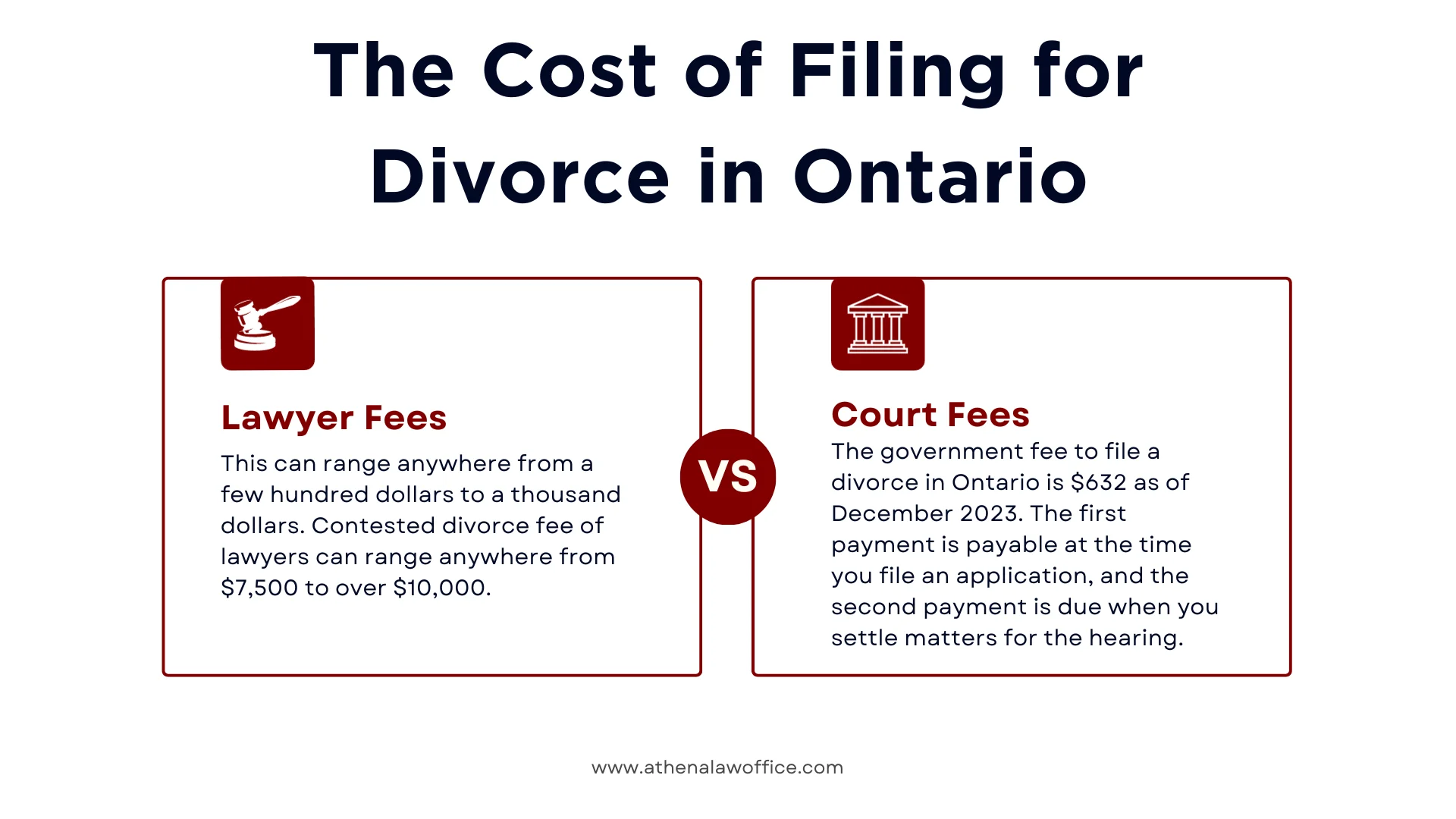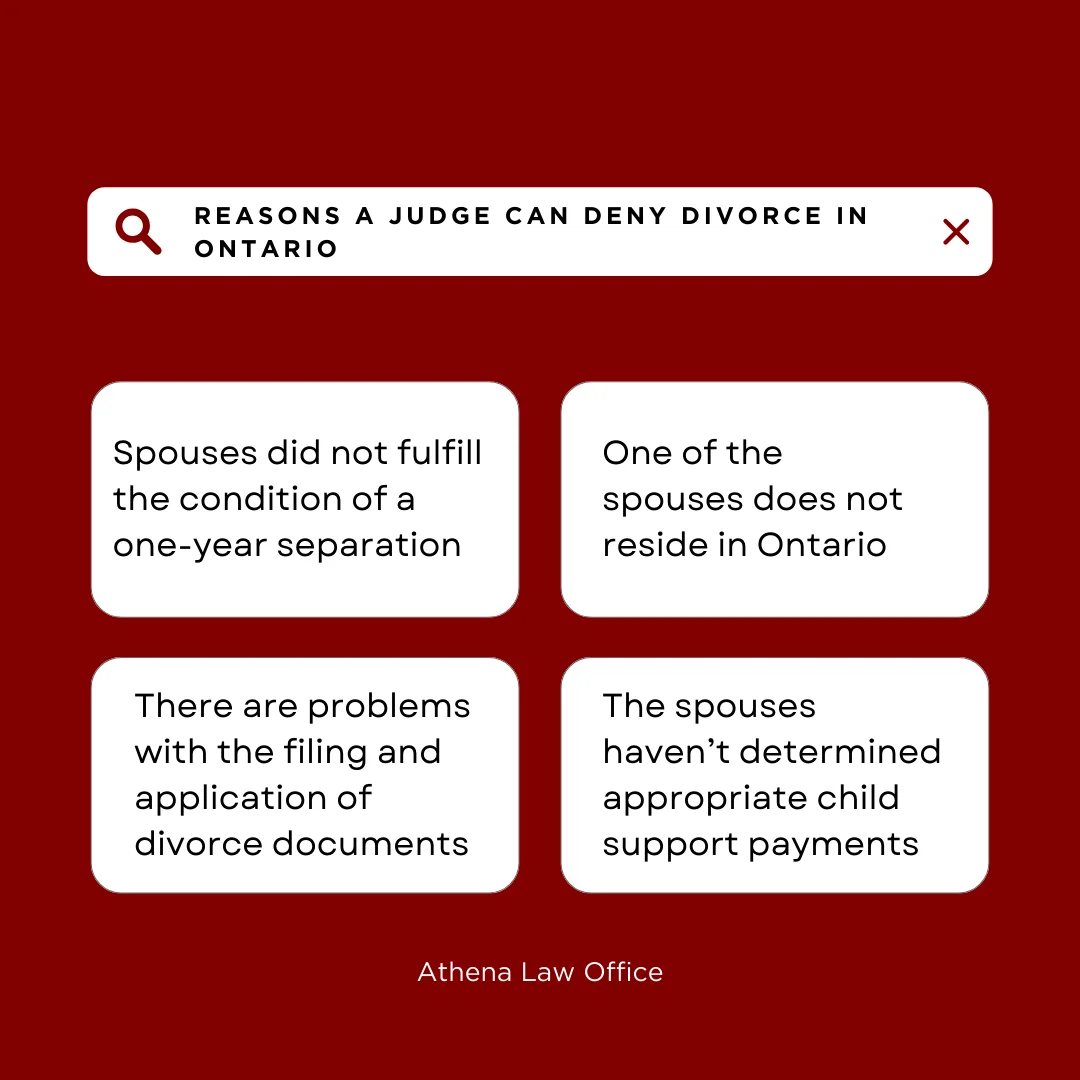Deciding to get a divorce is a complicated decision that involves a lot of forethought. While it takes an emotional toll, you also become curious to know what the process looks like and how long it will take.
It is only human to wonder when you are contemplating such a drastic decision. So, if you want to learn how to file for divorce in Ontario, you have stumbled upon the right place.
Our family lawyers have created a comprehensive guide for you to understand the divorce process in ten easy steps.
Grounds for Divorce in Ontario

According to the Divorce Act, the only reason for a divorce is a breakdown in the marriage. There are different ways you can showcase that your marriage has broken down.
These include the following:
- You and your spouse have been living apart for one year or more
- Your spouse has committed adultery
- Your spouse has been mentally or physically abusive towards you
You can apply for a divorce based on a one-year separation. In some cases, spouses separate but still live in the same house.
If you are confused about how to fulfill this divorce criteria, then we recommend reading our blog on the top twenty questions to ask a lawyer about separation in Canada.
How to File for Divorce in Ontario: 10 Effective Steps

Remember that the Divorce Act is a federal law. However, the territories and provinces in the country have different processes for filing a divorce.
You must complete the divorce application with the correct forms and file them in the relevant court in your province or territory.
For the purpose of this article, we will focus on Ontario and the relevant process there. So, here are the top ten steps you can follow to learn how to file a divorce in Ontario:
1. Determine if you meet the Grounds for Divorce
The first thing you need to determine is whether you meet the grounds for divorce. Remember that you must be legally married, and there should be no prospect of reconciliation between you and your spouse.
Another note to keep in mind for divorce in Ontario is that you or your spouse must have resided in Ontario for a minimum of a year before initiating the divorce proceedings.
2. Decide the Type of Divorce Application to File in Ontario
The next thing is to decide the type of divorce application you want to file. Many people also think an annulment and divorce are interchangeable, but they are not.
There are three types of divorce applications you can file in Ontario:
- Uncontested Joint Divorce
- Uncontested simple divorce
- Divorce with additional relief or contested divorce
Please note that an uncontested divorce has subcategories of a simple and joint divorce. You will have to fill out Form 8A for this purpose, and you will need to specify whether you are filing for a joint or simple divorce.
Let’s understand both these types in detail to avoid any issues during the divorce application process:
Contested vs. Uncontested Divorce
A contested divorce is one where your spouse objects to a few or all claims you have made in the application. Some of these claims can be asset division, spousal support, child support & custody, etc.
An uncontested divorce is where your spouse doesn’t contest to the divorce application. They accept all the claims you have made in the divorce application.
Simple vs. Joint Divorce
The main difference between a simple and joint divorce is the document serving. For example, when you file an application for a simple divorce, you also have to serve the application copy to your spouse.
On the other hand, when you file for a joint divorce, you don’t have to serve an application copy to your spouse.
If you want to file a divorce with additional relief, then you will have to file Form 8. The purpose of this is to seek additional relief from your spouse, such as support, asset division, and more.
If you are looking for the quickest way to get a divorce in Ontario, then we recommend filing for an uncontested divorce.
3. Gather and complete the Right Forms
Now that you have some basic information about how to file for divorce in Ontario, you must gather and complete the correct forms.
For a divorce in Ontario, you will have to file these forms, depending on the type of divorce:
- Contested divorce or with additional relief: Form 8
- Uncontested divorce: Form 8A
Both forms will require you to specify the grounds for a divorce and any claims you want to make, such as custody and support.
Remember to fill out these forms accurately if you want the divorce proceedings to take place without any issues. If you require help, we recommend you contact a divorce law attorney to facilitate this process.
4. File the Application with the Appropriate Court
Many people get confused about filing with the right court for a divorce in Ontario. Remember to file the application in the municipality where you or your spouse or children live.
For example, if you or your spouse reside in Halton, then you will have to submit your application in Milton. On the other hand, if you live in Peel, you will have to file the application with Brampton Superior Court.
Another important note to remember is to present your divorce application at the Superior Court of Ontario. Many people confuse this with the Ontario Court, but both of them are different.
If you want an effective method of finding the appropriate court near you in Ontario, then you can check all court locations here.
5. Serve the Application to Your Spouse
After filing the application with the correct court, it is time to serve it to your spouse. This is an important step because it lets your spouse know about the proceedings, and they can take the necessary steps they want.
It also gives your spouse an opportunity to respond to your application. There are various methods you can serve the divorce application to your spouse, which include the following:
- Serve the documents in person
- Send them by mail
- Utilize a server to serve the application
On the other hand, you will not need to follow these methods if you are filing for a joint uncontested divorce, as the spouse already knows.
6. Wait for 30 Days or Less for a Response
After serving the application, your spouse has thirty days to respond to it. You are also required to wait for a response before proceeding.
Remember that if your spouse lives outside the country, then this period will vary. It is important to discuss this with a divorce law attorney in Ontario to ensure you are proceeding correctly.
7. Prepare for a Possible Meeting with the Judge
If your spouse challenges your divorce application, then there will be a possible meeting with the Judge. Such a meeting is conducted to discuss the challenges in your divorce proceedings.
There might also be a discussion of the possibilities of a solution. On the other hand, if there is no consensus, then a judge will have to intervene to determine how you can proceed with the divorce.
It is crucial that you hire a family lawyer to facilitate you during this process. You have to be careful about what you say to ensure an effective outcome throughout the proceedings.
8. Bring Forward a Motion before Trial
With children or a lot of assets involved, a divorce in Ontario can be complicated. There may be urgent challenges you want to address, such as spousal support, child support, etc.
In such an event, you will have to bring forward a motion before the trial. A divorce attorney will help you file and proceed with these motions in the proper manner.
9. Trial Proceedings
Divorce is complicated, and there will be times when you and your spouse might not be able to reach an agreement. In such a case, you will have to take your case to trial.
When a case goes to trial, a judge has the authority to decide on all the issues you can’t agree on. During the trial, they will take the lead and ensure you and your spouse can come to some sort of reconciliation regarding your issues.
10. Receive your Divorce Order
Finally, the Judge will decide to grant you a divorce and issue the divorce order in Ontario. You will get a copy of this order from the courts.
It takes thirty-one days for the divorce order to be finalized. Once these days have passed, you must apply for a divorce certificate in Ontario, which will serve as legal evidence of your divorce.
How Long Does a Divorce Take in Ontario?
The length of the divorce proceedings depends on the type of divorce and how complex your case is. For example, it takes between four and six months to get a simple divorce in Ontario.
This is an uncontested divorce, which is easier and cheaper than other options. However, if you are going through a contested divorce and need to sort custody, support, assets, etc., then it can even take more than a year.
It is best to talk to a divorce attorney about this, as they will assess the complexity of your case and let you know how long it will take.
How Much Does it Cost to File for Divorce in Ontario?

Thegovernment fee to file a divorce in Ontario is $632 as of December 2023. The first payment is payable at the time you file an application, and the second payment is due when you settle matters for the hearing.
On the other hand, if you are hiring a divorce lawyer, then you will also have to pay their fees. This can range anywhere from a few hundred dollars to a thousand dollars.
Their fee will depend on the case complexity and other factors that will determine the costs.
Can the Judge Deny the Divorce Application in Ontario?

Yes, a judge can deny the divorce application in Ontario in some cases, but they need to have an important reason to do so. These can include the following:
- Spouses did not fulfill the condition of a one-year separation
- One of the spouses does not reside in Ontario
- There are problems with the filing and application of divorce documents
- The spouses haven’t determined appropriate child support payments
- And much more
The reason a judge can deny your divorce application in Ontario depends on how you have handled the case. Because of this, it is crucial to hire a family lawyer to help you with the divorce proceedings.
FAQs
Do I need a lawyer to get a divorce in Ontario?
You don’t need a lawyer to get a divorce in Ontario, but we recommend that you do. A divorce lawyer can offer you endless benefits that will help make the process legally and emotionally easier for you.
What is a wife entitled to in a divorce in Canada?
In Canada, each spouse is entitled to half of the value of the complete family property. The law states that the value of the property that the couple owned during the marriage that exists till the separation should be divided equally.
What forms can I fill out and submit online for divorce in Ontario?
Here are some forms you can fill and submit online for divorce in Ontario:
- Form 8A: Application for the divorce
- Form 25A: Divorce Order
- Form 36: Affidavit for Divorce
- Submitting a copy of your marriage certificate
What is the cheapest way to get a divorce in Ontario?
The cheapest way to get a divorce in Ontario is to opt for an uncontested divorce. It is perhaps the least costly and quickest way for you to get a divorce, as a contested divorce is costly and time-consuming.
Final Thoughts
Now that you know how to file for divorce in Ontario, you can begin the process with our step-by-step guide. However, we still recommend opting for a divorce attorney in Ontario who will help you during this process.
Athena Narsingh is one of the top family lawyers who can help you with the divorce proceedings. If you want help with your divorce in Ontario, please feel free to get in touch with us today.
Author Profile

- Barnett Law is a trusted and knowledgeable lawyer in Scarborough. Her expertise spans real estate law, family law, adoptions and fertility law. A lawyer by profession and a humanitarian by heart, Athena Narsingh Barnett wants to help people become more familiar with the legal system and be well-informed to make important legal decisions.
Latest entries
 legal guidanceNovember 12, 2025How To Avoid Land Transfer Tax Ontario?
legal guidanceNovember 12, 2025How To Avoid Land Transfer Tax Ontario? legal guidanceOctober 31, 2025How Much Is Land Transfer Tax In Ontario?
legal guidanceOctober 31, 2025How Much Is Land Transfer Tax In Ontario? Family LawOctober 27, 2025How Much Does A Divorce Cost In Ontario In 2025?
Family LawOctober 27, 2025How Much Does A Divorce Cost In Ontario In 2025? Family LawOctober 22, 2025Divorce Rate In Canada 2025: Top Divorce Statistics To Know
Family LawOctober 22, 2025Divorce Rate In Canada 2025: Top Divorce Statistics To Know

